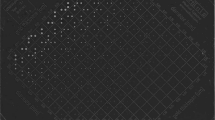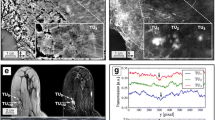Abstract
Background
Phase-contrast mammography (PCM) systems characteristically yield sharp images with edge enhancement and high-resolution 25-μm/pixel mammograms. However, not all PCM image information can be shown on the display at a resolution of 5-megapixel (5-MP), although 5-MP monitors are recommended for interpretation of digital mammograms. Therefore, we investigated the potential utility of a 15-mega-sub-pixel (15-MsP) display for PCM images.
Methods
We used a monitor that offered both 5-MP and 15-MsP displays by using a sub-pixel drive (SPD) technique to increase the spatial resolution of the monitor by threefold in the direction of the sub-pixels. Contrast-detail mammography phantom images were evaluated visually by four radiologic technologists. In this study, four display magnification ratios were used and the calculated image quality figures (IQFs) were compared with those of a 5-MP display.
Results
The detection capability of the 15-MsP display was significantly better than that of the 5-MP display at magnification ratios of 49 and 100 %. At other magnification ratios, the detection capability of the 15-MsP display was higher than that of the 5-MP display, but the difference was not significant.
Conclusions
A 15-MsP display has the potential to provide better detection than that provided by conventional 5-MP displays. A 15-MsP display using SPD technology is suitable for high-resolution digital mammograms, such as those produced by PCM systems.




Similar content being viewed by others

References
Lewin JM, D’Orsi CJ, Hendrick RE, Moss LJ, Isaacs PK, Karellas A, et al. Clinical comparison of full-field digital mammography and screen-film mammography for detection of breast cancer. Am J Roentgenol. 2002;179:671–7.
Skaane P, Young K, Skjennald A. Population-based mammography screening: comparison of screen-film and full-field digital mammography with soft-copy reading-Oslo I study. Radiology. 2003;229:877–84.
Skaane P, Hofvind S, Skjennald A. Randomized trial of screen-film versus full-field digital mammography with soft-copy reading in population-based screening program: follow-up and final results of Oslo II study. Radiology. 2007;244:708–17.
Pisano ED, Hendrick RE, Yaffe MJ, Baum JK, Acharyya S, Cormack JB, et al. Diagnostic accuracy of digital versus film mammography: exploratory analysis of selected population subgroups in DMIST. Radiology. 2008;246:376–83.
Hambly NM, McNicholas MM, Phelan N, Hargaden GC, O’Dohery A, Flanagan FL. Comparison of digital mammography and screen-film mammography in breast cancer screening: a review in the Irish breast screening program. Am J Roentgenol. 2009;193:1010–8.
Kamitani T, Yabuuchi H, Soeda H, Matsui Y, Okafuji T, Sakai S, et al. Detection of masses and microcalcifications of breast cancer on digital mammograms: comparison among hard-copy film, 3-megapixel liquid crystal display (LCD) monitors and 5-megapixel LCD monitors: an observer performance study. Eur Radiol. 2007;17:1365–71.
Yamada T, Suzuki A, Uchiyama N, Ohuchi N, Takahashi S. Diagnostic performance of detecting breast cancer on computed radiographic (CR) mammograms: comparison of hard copy film, 3-megapixel liquid-crystal-display (LCD) monitor and 5-megapixel LCD monitor. Eur Radiol. 2008;18:2363–9.
Pisano ED, Yaffe MJ. Digital mammography. Radiology. 2005;33:353–62.
Shiraishi A. Current state of digital mammography. Breast Cancer. 2008;15:194–9.
Yamada T. Current status and issues of screening digital mammography in Japan. Breast Cancer. 2010;17:163–8.
Ishibashi T, Kawasumi Y, Yamada T, Sai M, Uematsu T, Uchiyama N. Digital mammographic screening in Japan. Breast Cancer. 2010;17:159–62.
Honda C, Ohara H, Gido T. Image qualities of phase-contrast mammography. In: Susan Astley M, editor. IWDM 2006. LNCS, vol. 4046. Heidelberg: Springer; 2006. p. 281–8.
Tanaka T, Honda C, Matsuo S, Noma K, Oohara H, Nitta N, et al. The first trial of phase contrast imaging for digital full-field mammography using a practical molybdenum X-ray tube. Invest Radiol. 2005;40:385–96.
Yamazaki A, Ichikawa K, Kodera Y. Investigation of physical image characteristics and phenomenon of edge enhancement by phase contrast using equipment typical for mammography. Med Phys. 2008;35:5134–50.
Morita T, Yamada M, Kano A, Nagatsuka S, Honda C, Endo T. A comparison between film-screen mammography and full-field digital mammography utilizing phase contrast technology in breast cancer screening programs. In: Krupinski EA, editor. IWDM 2008. LNCS, vol. 5116. Heidelberg: Springer; 2008. p. 48–54.
Ichikawa K, Kodera Y, Nishi Y, Hayashi S, Hasegawa M. Development of a new resolution enhancement technology for medical liquid crystal displays. In: Steven C, Steven Horii C, Katherine P, Katherine Andriole P, editors. Medical imaging 2007: PACS and imaging informatics, vol. 6516. USA: Proc of SPIE; 2007. p. 65160W1–65160W8.
Ichikawa K, Hasegawa M, Kimura N, Kawashima H, Kodera Y. A new resolution enhancement technology using the independent sub-pixel driving for the medical liquid crystal displays. IEEE J Disp Technol. 2008;4:377–82.
Ichikawa K, Kawashima H, Kimura N, Hasegawa M. Clinical usefulness of super high-resolution liquid crystal displays using independent sub-pixel driving technology. In: Krupinski EA, editor. IWDM 2008. LNCS, vol. 5116. Heidelberg: Springer; 2008. p. 84–90.
Nishimura A, Ichikawa K, Mochiya Y, Morishita A, Kawashima H, Yamamoto T, et al. Preliminary investigation of the clinical usefulness of super-high-resolution LCDs with 9 and 15 mega-sub-pixels: observation studies with phantoms. Radiol Phys Technol. 2010;3:70–7.
Yamada S, Hirata Y, Ishii R, Ogawa T. Visual evaluation and usefulness of medical high-resolution liquid-crystal displays with use of independent sub-pixel driving technology. Radiol Phys Technol. 2011;4:12–33.
National Electrical Manufacturers Association. Digital Imaging and Communications in Medicine (DICOM), Part 14: Grayscale Standard Display Function PS 3.14, 2007.
Thomas JA, Chakrabarti K, Kaczmarek R, Romanyukha A. Contrast–detail phantom scoring methodology. Med Phys. 2005;32:807–14.
Rivetti S, Lanconelli N, Campanini R, Bertolini M, Borasi G, Nitrosi A, et al. Comparison of different commercial FFDM units by means of physical characterization and contrast–detail analysis. Med Phys. 2006;33:4198–209.
van der Burght R, Thijssen M, Bijkerk R. Manual: contrast–detail phantom CDMAM 3.4. Version 7. Nijmegen: Artinis Medical Systems BV; 2010.
Thijssen MAO, Bijkerk KR, van der Burght RJM. Manual: contrast–detail phantom artinis CDRAD type 2.0. Project quality assurance in radiology. Nijmegen: University Medical Center; 1998.
Ideguchi T, Higashida Y, Himuro K, Ohki M, Nakamura S, Yoshida A, et al. Full-field digital mammography with amorphous silicon-based flat-panel detector: physical imaging characteristics and signal detection (in Japanese with English abstract). Jpn J Radiol Technol. 2004;60:399–405.
Bacher K, Smeets P, De Hauwere A, Voet T, Duyck P, Verstraste K, et al. Image quality performance of liquid crystal displays: influence of display resolution, magnification and window settings on contrast–detail detection. EJR. 2006;58:471–9.
Hatanaka S, Morishita J, Hiwasa T, Dogomori K, Toyofuku F, Ohki M, et al. Comparison of viewing angle and observer performances in different types of liquid-crystal display monitors. Radiol Phys Technol. 2009;2:166–74.
Vahey K, Ryan E, McLean D, Poulos A, Rickard M. A comparison between the electronic magnification (EM) and true magnification (TM) of breast phantom images using a CDMAM phantom. EJR. 2012;81:1514–9.
European Commission. European guidelines for quality assurance in breast cancer screening and diagnosis. In: Perry N, Broeders M, Wolf de C, et al., eds. 4th ed. Office for Official Publications of the European Communities, Luxembourg 2006.
Matsumoto M, Nishizawa K, Akiyama Y, Horita K, Kato H, Ishioka A. The mean breast thickness for Japanese patients for use in estimating the glandular dose in mammography (in Japanese with English abstract). J Jpn Assoc Breast Cancer Screen. 2000;9:95–102.
Asada Y, Suzuki S, Yamada M, Sakurai K, Susa H, Maeda S, et al. Effect of breast composition on patient exposure in mammography (in Japanese with English abstract). Japan J Radiol Technol. 2004;60:1675–81.
Kawaguchi A, Matsunaga Y, Otsuka T, Suzuki S. Patient investigation of average glandular dose and incident air kerma for digital mammography. Radiol Phys Technol. 2014;7:102–8.
Yamazaki A, Ichikawa K, Kodera Y, Funahashi M. Overall noise characteristics of reduced images on liquid crystal display and advantages of independent subpixel driving technology. Med Phys. 2013;40:21901–8.
Acknowledgments
This work was supported in part by a Grant-in-Aid for the Research Recovery Promotion Project (241FS0027) from the Japan Science and Technology Agency.
Conflict of interest
The authors declare that they have no conflict of interest.
Author information
Authors and Affiliations
Corresponding author
About this article
Cite this article
Takane, Y., Kawasumi, Y., Sato, M. et al. Evaluating clinical implications of 15-mega-sub-pixel liquid-crystal display in phase-contrast mammography. Breast Cancer 23, 561–567 (2016). https://doi.org/10.1007/s12282-015-0603-1
Received:
Accepted:
Published:
Issue Date:
DOI: https://doi.org/10.1007/s12282-015-0603-1



